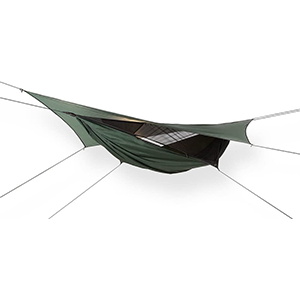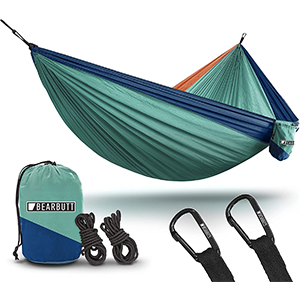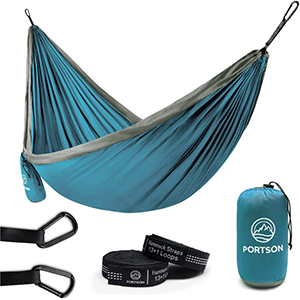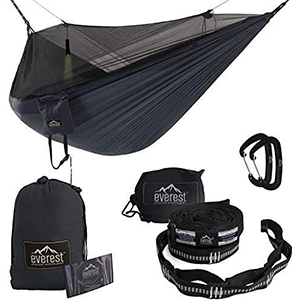The decision between a tent and a tarp for shelter typically comes down to personal preference.
An excellent substitute, though, is a survival hammock.
In addition to being far more comfortable than sleeping on the ground, hammocks are also lightweight and simple to conceal.
There are several factors to take into account when selecting a best survival hammock for different situations. What you need to know and how to choose the finest one are provided here.
Potential Problems
You must first be aware of the drawbacks of hammock camping in order to choose the finest survival hammock. Then you can locate a hammock or other arrangement that addresses these issues.
Initial issue: Cold Butt Syndrome
The main drawback of hammocks is their extreme cold.
Even if you use a sleeping bag inside the hammock, the pressure from your body will cause the sleeping bag to compress, which will let chilly air circulate beneath you.
The first option is to use an underquilt, which is essentially a sleeping bag that wraps over your hammock, however they are too heavy to be used as bug out bags.
Put a sleeping mat inside your hammock as a backup plan.
Mummy-shaped sleeping pads will work best for hammocks. If not, the pad will slide about within the hammock and not fit well.
Issue 2: Rain
Rain and storms are not protected at all by hammocks.
For protection, you can use a tarp or rainfly, but this will increase your load. You risk getting soaked even with the tarp if raindrops fall on your suspension straps.
Solution: Select a portable rain fly AND become familiar with its assembly. Yes, you must attempt setting up the rain fly on the field!
The simple fix for the raindrops falling on your suspension straps is to install a drip cable.
It’s just some paracord that is dangling from the straps. Rain will be deflected away from your hammock and down upon it.
Issue 3: Storage of Equipment
You may store your equipment inside a tent while sleeping in one. In a hammock, you won’t want to sleep with your equipment.
You may just place it on the ground directly beneath you on favorable days. But if it starts to rain, you run the danger of your equipment becoming wet and destroyed.
Purchase a quality waterproof cover for your pack is one solution. Use a waterproof backpack if necessary (an option worth considering for bug out backpacks anyway).
Some campers who use a hammock may rope a ridgeline above it so they can hang items from it.
However, it takes some experience to knot a line securely enough to support a large pack. Alternatively, you may suspend equipment using the straps on the hammock.
Issue 4: Trees Don’t Always Exist
You can always erect a tent, even if the ground is unfavorable (rocky, sandy, slope, etc.). Hammocks are not the same as this!
Solution: Before you pack your survival backpack, decide where you’re going. Don’t bring a hammock with you if you’re heading somewhere with few trees!
Additionally, you need to make sure that your suspension straps are long enough.
If you just have short straps, you are constrained to finding two trees that are perfectly spaced apart.
Issue 5: This Isn’t the Best Option for Many People
Although there are twin hammocks, I don’t like them. You might not save much weight if each individual carries their own hammock.
Solution: Carry out the calculations. Compare the weight of a tent setup against a hammock arrangement for your group. Then think about your destination and whether it makes sense to bring a hammock rather than a tent.
Issue 6: mosquitoes
In a survival hammock, you don’t have to worry about bears (any more than you would in a tent, at least).
But mosquitoes may be a major issue.
Bring a mosquito net with you or get a hammock with one built in. Although this adds weight to your equipment, it is still preferable to being devoured alive.
What Kind of Hammock Are You Looking For?

You’ll be astonished at how many possibilities there are once you start looking.
They range from sophisticated hammock camping arrangements for the winter to lightweight hammocks for hiking.
These are the main considerations you need to make your selection based on:
Size:
Larger hammocks are typically far more comfy than smaller ones. However, the additional material will make your pack heavier and bulkier.
Some are built to accommodate two individuals (double hammocks). I find it to be quite difficult to sleep two within a hammock, no matter how large it is. If you have to get up in the middle of the night to use the restroom, you’ll also wake up your companion.
I strongly advise avoiding sharing a hammock! A double for one person, however, implies more space and comfort.
Material:
A high-quality item made of cloth that won’t rip or puncture easily is what you desire. You will physically fall out of it if you don’t.
Look at the weight rating instead of attempting to understand the various hammock material varieties. You can determine the hammock’s strength from this.
Shape:
A hammock with a spreader bar is NOT what you want. In addition to being unsafe for sleeping in, spreader bar hammocks are exceedingly difficult to pack in a bug out bag. You’ll tumble out!
However, sleeping in a curve isn’t particularly comfortable, particularly for those with back problems.
- Sleeping at an angle is the answer. The flat lie is easier to attain in this posture.
- Some higher-end camping hammocks have an asymmetrical design.
- This makes it easier to get a flat lie without sleeping on your side.
- View the video below if you’re unaware about how to sleep on a hammock.
Two Layers:
A compartment in double-layer hammocks is designed to accommodate a sleeping pad. They are hence far more suitable for usage in cold climates.
A big (but sometimes disregarded) advantage of double-layer hammocks is that they keep mosquitoes from biting you from the bottom up.
Yes, mosquitoes may through the flimsy fabric used in the majority of portable hammocks!
Accessories:
You’ll require a way to suspend the hammock (such as straps or whoopie slings). Although it’s more difficult than you may imagine, you could hang your hammock with rope.
Unfortunately, hammock straps often need to be purchased separately.
For your hammock, a tarp or rain fly cover and a mosquito net are likely additional necessities.
Price:
It could be OK to spend $20 on a hammock if all you want to do is relax there.
Spend considerably more if you’re seeking for a survival hammock.
You want a hammock that will stand up in adverse weather conditions and comes from a reputed brand.
| Image | Product Name | Editor's Rating | Price |
|---|---|---|---|
 | Best All-rounder: ENO Eagles Nest | Check Price | |
 | Hennessy Expedition | Check Price | |
 | Bear Butt Double | Check Price | |
 | Kammock Ultralight | Check Price | |
 | Everest Double | Check Price |
Best Survival Hammock For Different Situations Reviews
1. Best All-rounder: ENO Eagles Nest
Although it isn’t the greatest hammock on the market, the ENO Eagles Nest works admirably in practically all areas.
It is really sturdy, not overly heavy, cozy, and easy to assemble.
The ENO Eagles Nest is reasonably priced for a survival hammock of this kind. You would appreciate having some of the Reflective Survival Tarp, so take a moment to check them out.
Notably, the cost does not include straps, a mosquito net, or a rainfly. Even if you factor in these expenses, The Eagles Nest remains an excellent deal.
2. Hennessy Expedition
The Expedition is the most well-known type from Hennessy, one of the greatest manufacturers of camping hammocks. Its asymmetrical layout makes it easier to acquire a flat lie and allows for more comfortable sleeping.
This hammock’s weight considering its size is the one serious drawback. The rainfly and mosquito net are not included in the weight, thus the overall arrangement will make you feel heavier.
However, the Expedition is heavier due of how well it withstands harsh weather and usage.
This hammock is among the strongest ones available because to its heavy-duty nylon construction and double-stitched seams. You may also like some of the Kerosene Lantern for Camping from our list.
Be aware that setting up the Hennessy requires a little bit of effort. Before using a hammock for camping, you should experiment with it at home if you are new to the practice.
3. Bear Butt Double
This survival hammock is a terrific option even though it is reasonably priced.
It is huge and really comfortable, doesn’t weigh much, is sturdy, and is simple to assemble.
There is a rope included with the Bear Butt for hanging the hammock. These ropes are not very dependable and are difficult to use.
You need purchase a set of suspension straps. Although it increases the price, this is quite worthwhile.
4. Kammock Ultralight
When it comes to lightweight hammocks, I don’t believe you can go any lighter than this. Even unique straps were added by the manufacturer to the hammock to save weight! Additionally, it collapses into a little size.
A hammock this light will inevitably have certain shortcomings. The wind will be audible through the fabric.
Because the ultralight nylon isn’t very strong, avoid thorns and jagged tree branches.
The hammock is smaller than usual to reduce weight. This hammock won’t be particularly comfy for someone who is 6 feet tall. Even shorter individuals will struggle to attain a diagonal lay.
However, if survival above comfort is what we’re about, this is a fantastic hammock for minimal carrying.
5. Everest Double
The Everest Double Hammock has a number of features that I adore. The primary benefit is the built-in insect net, which eliminates the need to hang a net.
However, it would be wonderful if there were more places to hang the bug net.
The net can now hang on your face. In addition to being bothersome, that increases the risk of mosquito bites.
The hammock touts its ability to be turned around, which is a wonderful feature. Unfortunately, this function is somewhat worthless because the zippers are only on one side.
The Everest is still the best survival hammock for different situations despite these shortcomings, and since it comes with straps, it is an even better bargain.
